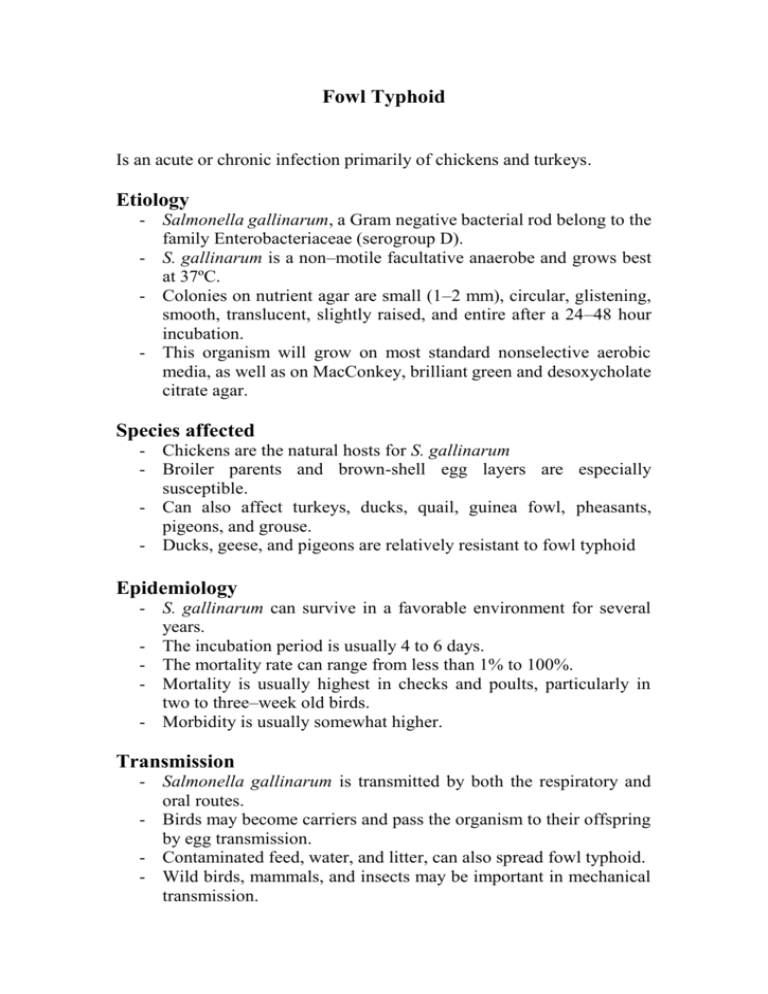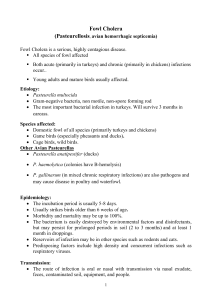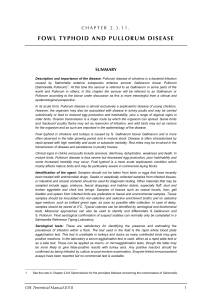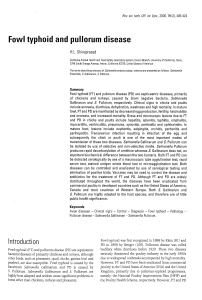Fowl Typhoid Is an acute or chronic infection primarily of chickens
advertisement

Fowl Typhoid Is an acute or chronic infection primarily of chickens and turkeys. Etiology - Salmonella gallinarum, a Gram negative bacterial rod belong to the family Enterobacteriaceae (serogroup D). - S. gallinarum is a non–motile facultative anaerobe and grows best at 37ºC. - Colonies on nutrient agar are small (1–2 mm), circular, glistening, smooth, translucent, slightly raised, and entire after a 24–48 hour incubation. - This organism will grow on most standard nonselective aerobic media, as well as on MacConkey, brilliant green and desoxycholate citrate agar. Species affected - Chickens are the natural hosts for S. gallinarum - Broiler parents and brown-shell egg layers are especially susceptible. - Can also affect turkeys, ducks, quail, guinea fowl, pheasants, pigeons, and grouse. - Ducks, geese, and pigeons are relatively resistant to fowl typhoid Epidemiology - S. gallinarum can survive in a favorable environment for several years. - The incubation period is usually 4 to 6 days. - The mortality rate can range from less than 1% to 100%. - Mortality is usually highest in checks and poults, particularly in two to three–week old birds. - Morbidity is usually somewhat higher. Transmission - Salmonella gallinarum is transmitted by both the respiratory and oral routes. - Birds may become carriers and pass the organism to their offspring by egg transmission. - Contaminated feed, water, and litter, can also spread fowl typhoid. - Wild birds, mammals, and insects may be important in mechanical transmission. - Red mites, in particular, are involved in spreading fowl typhoid - Birds can ingest bacteria after environmental contamination or during cannibalism. Wound infections are also possible. Clinical signs In chicks and poults, the clinical signs of fowl typhoid can include: - Depression, loss of appetite. - Somnolence. - Droopy wings, ruffled feathers, and weakness. - Huddling and reluctance to move - Dehydration, thirst. - Yellow or green diarrhea with pasting of the vent feathers is common. - There may be blindness or swelling of the joints. - Birds that survive may be underweight and poorly feathered, and may not mature into productive adults. In growing and adult birds, the disease can be in-apparent. In symptomatic infections, the clinical signs may include - Decreased appetite. - Depression. - Dehydration and ruffled feathers. - Diarrhea or a droopy appearance. - Weight loss. - Pale and shrunken combs. - There may also be a decrease in egg production or fertility. Post mortem lesions In young birds: - Bronzed enlarged liver with small necrotic foci, and /or congestion. Capsule of the liver may contain fibrinous exudates. - The spleen is often enlarged and mottled - The kidneys may be enlarged. - Enteritis of anterior small intestine, Anemia - Petechial hemorrhages can sometimes be found in the fat and musculature surrounding the internal organs, and the peritoneum, pericardium, - In some birds, there are white nodules in the epicardium, myocardium, pancreas, lung, gizzard, and sometimes the cecum; some of these nodules may resemble tumors. - The joints may be swollen and contain a viscous creamy fluid. - In turkeys, a characteristic sign is the appearance of small, white plaques visible through the wall of the intestine In adult birds: the gross lesions may be minimal. - There may be a mottled pancreas. - Excess pericardial fluid, fibrinous pericarditis. - Caseous granulomas in the lungs and air sacs. - The testes sometimes contain white foci or nodules. - Chronic carrier hens may have nodular or regressing ovarian follicles, or a few misshapen ova among normal ovules. - In hens, caseous material is often found in the oviduct, and peritonitis, perihepatitis, or ascites may be seen. Diagnosis - Clinical signs, flock history, mortality, and post–mortem lesions. - Isolation and identification of S. gallinarum - Polymerase chain reaction (PCR) tests have also been used to detect S. gallinarum. - *Serologic tests: include i. The rapid whole blood agglutination test can be used to immediately identify reactors in the field, but is not reliable in turkeys. ii. The rapid serum agglutination test iii. Tube agglutination, , iv. Immunodiffusion, v. Enzyme–linked immunosorbent (ELISA) assays. * Cross–reactions with other species of Salmonella, particularly S. enteritidis may occur. Testing for reactors should be repeated at three to five week intervals, as a single test may not detect all carrier birds. Treatment with antibiotics during the 2 to 3 weeks before testing may lead to false negatives. Differential diagnosis - Fowl typhoid must be differentiated from infection with other species of Salmonella, Mycoplasma synoviae, Staphylococcus aureus, Pasteurella multocida, Erysipelothrix rhusiopathiae - pullorum disease and coli-septicaemia - Fungi including Aspergillus. - The white nodules in chicks can be confused with Marek’s disease. - Hepatic lesions caused by Yersinia pseudotuberculosis. - In adult carriers, local S. gallinarum infections may resemble infections by staphylococci, streptococci, coliform bacteria, other salmonellae, and P. multocida. Treatment: Amoxycillin, potentiated sulponamide, tetracylines and fluoroquinolones Eradication is the preferred method, as recovered birds have a tendency to become carriers. Prevention: - Biosecurity, - Clean chicks. As with other salmonellae, recovered birds are resistant to the effects of infection but may remain carriers. - Vaccines for fowl typhoid have been used in some areas, both live (usually based on the Houghton 9R strain) and bacterins. Dr. firas Hussien dept. of pathology. Dr. firas Hussien dept. of pathology.











